Bringing a new puppy into your home is an exciting time, filled with cuddles, playtime, and the beginning of a lifelong bond. One of the most critical early steps to ensure a long and happy life together is learning How To Properly Potty Train A Puppy. This foundational training not only establishes good behavior but also helps your furry friend understand routines, keeping your living space clean and pleasant. Before your new companion arrives, researching effective housetraining strategies and creating a tailored plan can set you both up for success. Understanding your puppy’s needs and consistently applying proven methods will foster a positive relationship right from the start, making the transition smoother for everyone.
For young puppies, the journey of early puppy training can begin as early as 12 weeks old, laying the groundwork for future good habits.
The Core Importance of Potty Training
Amidst the endless list of skills your puppy needs to acquire, from recognizing their name to basic obedience, housetraining stands out as a top priority. It’s more than just preventing accidents; it’s about building a strong foundation for your puppy’s overall behavior and well-being. A successfully potty-trained puppy is a happier puppy, and a clean home contributes significantly to the joy of pet ownership. This essential training helps your puppy establish a predictable routine, reinforces positive habits, and prevents unpleasant odors, ultimately strengthening the bond between you and your canine companion.
Effective Potty Training Methods
While every puppy is unique, there are several tried-and-true methods that trainers widely recommend for successful housetraining. According to Mary Burch, Ph.D., director of the AKC’s Canine Good Citizen and S.T.A.R. Puppy programs, each method has its advantages, but consistency and adherence to basic tips are universal keys to success.
Harnessing the Power of Crate Training
Dog crates are invaluable tools that can simplify many aspects of puppy ownership, including potty training. Dogs are naturally den animals, seeking secure, comfortable spaces. This innate behavior makes it relatively easy to train your dog to love their crate, transforming it into their private, secure haven.
The fundamental principle behind using a crate for housetraining is a dog’s natural inclination to keep their living space clean. They are unlikely to eliminate where they sleep. Therefore, it’s crucial to select a crate that is appropriately sized—just large enough for your puppy to stand up, lie down, and turn around comfortably. If the crate is too spacious, a puppy might designate one corner for elimination and still have enough room to sleep away from the mess, defeating the purpose. Many modern crates come with partitions, allowing you to adjust the size as your puppy grows. When a puppy feels the urge to relieve themselves, they will often signal this by whining or scratching, indicating their desire to be let out of their den immediately. Allowing accidents within the crate can teach them that it’s acceptable to soil their personal space, potentially leading to accidents elsewhere in your home.
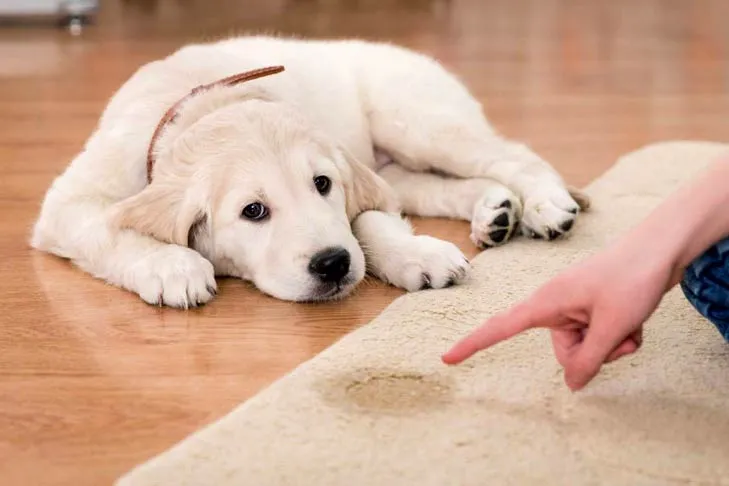 Golden Retriever Puppy Accident
Golden Retriever Puppy Accident
Utilizing Puppy Pads and Paper Training
The use of puppy pads and paper training can be a nuanced approach, as it reinforces two distinct options for a puppy: eliminating indoors and outdoors. Ideally, puppies learn to hold their bladder indoors and relieve themselves exclusively outside. However, certain circumstances may necessitate indoor options, such as for owners with demanding work schedules that prevent frequent outdoor breaks, or for very small breeds and puppies living in harsh winter climates.
Puppy pads offer an approved indoor spot for your dog to relieve themselves. There are also specialized indoor dog potties, including designs suitable for male dogs. Once the dog matures, owners can then transition them to doing their business exclusively outdoors. For those specifically training your dog to use pads, consistency in placement and positive reinforcement are vital.
Establishing a Consistent Housetraining Schedule
A consistent housetraining schedule is paramount for success. Puppies have small bladders and rapid digestive systems, meaning they need frequent opportunities to go potty. Providing these opportunities is key to teaching them the correct behavior.
A general guideline suggests that puppies can control their bladders for approximately the number of hours equal to their age in months, up to about 9 to 12 months old. For example, a 6-month-old puppy can typically hold it for about six hours. However, remember that 10 to 12 hours is a long stretch for any dog, and individual differences exist.
When developing your puppy’s schedule, observe their daily habits closely. Young puppies generally need to be taken out:
- First thing in the morning and last thing at night.
- After playing indoors.
- After waking up from a nap or spending time in their crate.
- After eating, drinking, or chewing on a toy or bone.
This might mean taking your puppy outside a dozen or more times within a 24-hour period. If you work outside the home, consider making arrangements for someone to let your puppy out during the day, such as a trusted dog walker or a friend. The sooner your puppy understands the designated potty areas and which places are off-limits, the quicker you can move past the initial messy stages. When taking your puppy outside, it’s also a good opportunity to address any issues like a puppy pulling on the leash, reinforcing good outdoor manners.
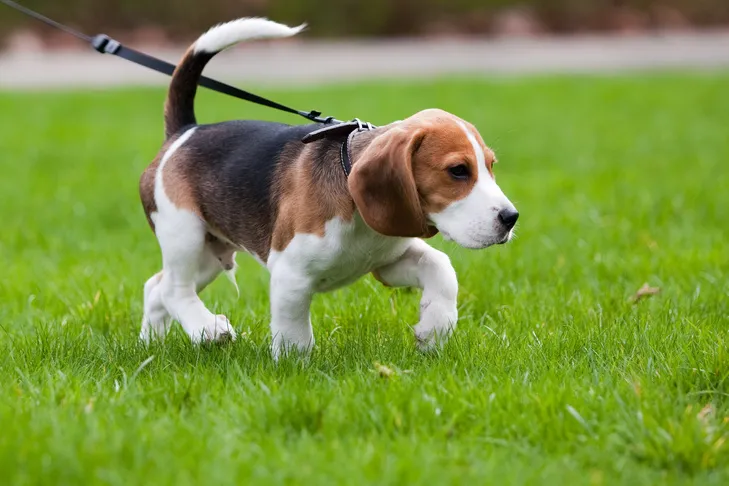 Beagle puppy on leash walking in the grass.
Beagle puppy on leash walking in the grass.
Observing and Supervising Your Puppy’s Cues
Careful observation and supervision are crucial for understanding your puppy’s unique signals and rhythms. Some puppies may have stronger bladder control than others, while some might need to go out every time they become excited or engage in play. You might even notice some puppies pause mid-play, relieve themselves, and then resume playing. Much like human babies, canine potty habits are highly individual and require attentive monitoring to catch cues early.
Managing Your Puppy’s Diet for Better Potty Training
Puppies possess immature digestive systems, which means they cannot efficiently process large quantities of food. It is generally recommended to divide your puppy’s daily food intake into three smaller meals. The quality of the puppy food itself is also a significant factor; opt for the highest quality food that agrees with your puppy’s system.
Monitoring your dog’s stool is the best way to determine if their diet is suitable. Consistently bulky, loose, or malodorous stools may indicate a need to consult your vet. They might suggest switching to a new dog food. Overfeeding can also lead to diarrhea, which will undoubtedly complicate the housetraining process. A balanced, appropriate diet is fundamental to a consistent potty schedule.
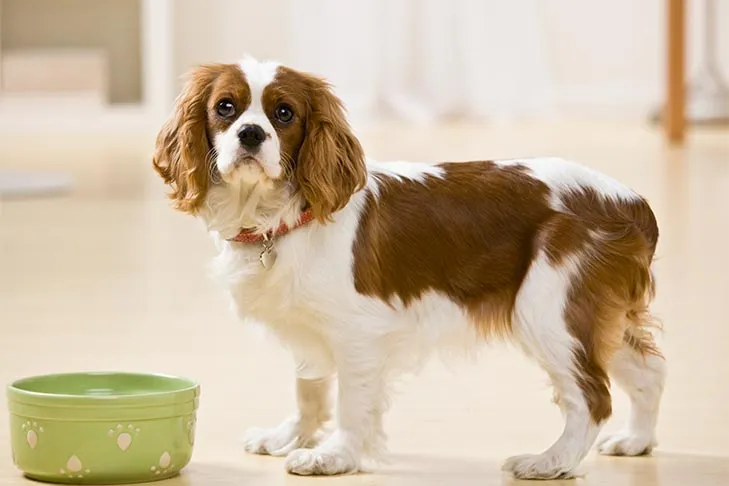 Cavalier King Charles Spaniel standing next to its food bowl at home.
Cavalier King Charles Spaniel standing next to its food bowl at home.
Positive Reinforcement: The Key to Outdoor Success
Scolding a puppy for an indoor accident, especially after the fact, is largely ineffective and can confuse your dog. Instead, positive reinforcement—lavishing praise and rewards for successful outdoor elimination—is the most effective training approach. Make your puppy feel like a canine prodigy every time they perform this natural act in the designated area.
Be enthusiastic with your praise: cheer, clap, and offer small, easily digestible treats. Your puppy should understand that this accomplishment is incredibly important. When your dog has an accident indoors, Dr. Burch advises against making a fuss. Simply clean up the mess thoroughly. Use an enzymatic cleaner that eliminates odors to remove any lingering scent that might encourage your puppy to use the same spot again. Blot up liquids from carpets before applying the cleaner.
If you catch your puppy in the act of squatting indoors, immediately pick them up and rush them outside. If they finish their business outdoors, provide immediate praise and positive reinforcement. Remember, for effective housetraining, prevention and positive reinforcement are the most powerful tools.
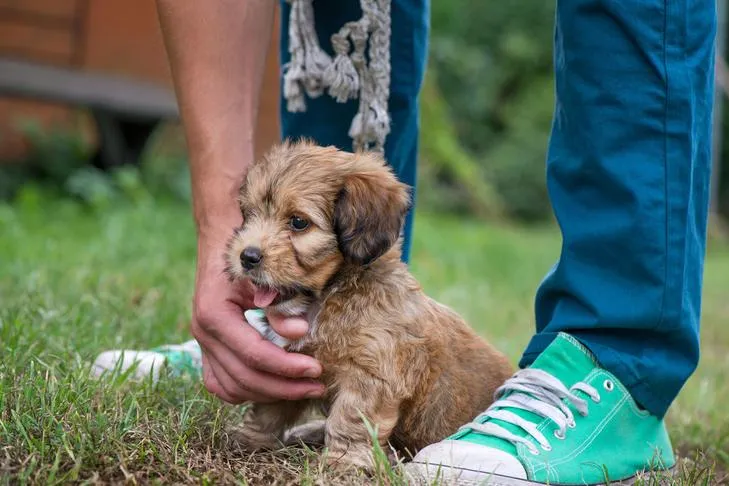 Puppy being trained in the grass.
Puppy being trained in the grass.
Troubleshooting Common Potty Training Challenges
While following these guidelines generally leads to a well-house-trained puppy, sometimes the process doesn’t go as smoothly as planned.
Dr. Burch points out that persistent house soiling can sometimes signal an underlying physical issue. If a dog seems impossible to housetrain by several months of age, a thorough veterinary check-up is recommended. If your vet confirms your dog is healthy, the next step would be to consult a professional trainer or animal behaviorist experienced in addressing such issues.
Here are some common challenges trainers frequently encounter:
Dealing with Frequent Indoor Accidents
This issue is particularly common among owners of Toy breeds. Some trainers suggest teaching these smaller puppies to use designated indoor potty spots, similar to a cat’s litter box. Beyond standard puppy pads, there are specialized dog potty boxes available for indoor use. With consistent effort, even small dogs can be successfully housetrained, though it may require a bit more time and focused attention.
Eliminating Repeat Accident Spots
If your dog repeatedly pees in the same spot indoors, it’s highly probable that the area was not cleaned effectively. Residual odors can signal to your dog that this is an acceptable potty area. Your new puppy supply kit should always include plenty of pet stain enzymatic cleaners. Always follow the product instructions carefully to ensure the scent is completely neutralized.
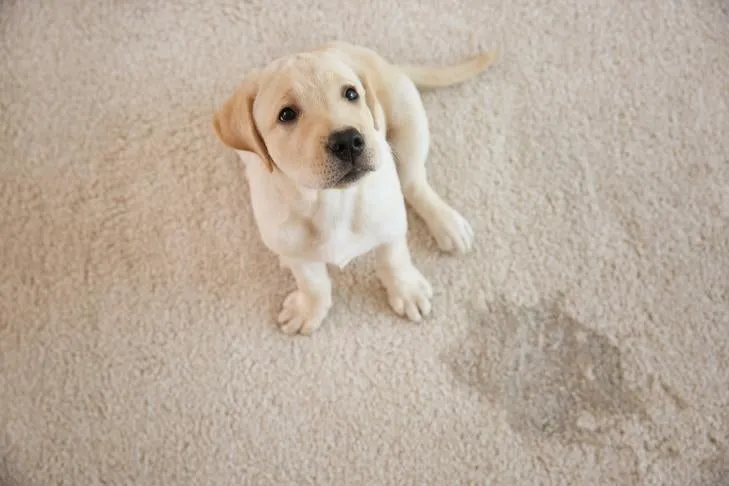 Yellow Labrador retriever puppy sitting on carpet at home next to a pee accident.
Yellow Labrador retriever puppy sitting on carpet at home next to a pee accident.
Avoiding Premature Freedom in the House
A common mistake among dog owners is granting their puppy too much freedom too soon. Seeing early signs of understanding can lead owners to declare victory prematurely. Even when your puppy seems to be grasping the concept, it’s vital to maintain a strict schedule and supervision to fully ingrain good habits. Consistency during this crucial period prevents setbacks and ensures long-term success.
Addressing Crate Soiling Issues
Dr. Burch notes that rescued dogs, particularly those who were confined for extended periods and had no alternative but to eliminate in their kennels, often present with crate soiling issues. The most effective strategy is to revert to the basics of crate and house training. This involves:
- Assessing your dog’s bladder and bowel control outside the crate.
- Carefully controlling their diet and strictly adhering to a schedule.
- Providing very frequent outdoor trips, especially after meals, first thing in the morning, and last thing at night.
- If you work or are away for long periods, arrange for a dog walker or a trusted individual to let your dog out.
- Always ensure thorough cleaning to eliminate all odors after any indoor accident.
These steps are particularly important when you need to potty train a rescue dog, as they may have past experiences that require extra patience and specific training approaches.
Understanding the Potty Training Timeline
The duration of puppy potty training can vary significantly, influenced by factors such as age, prior learning experiences, and your chosen methods and consistency. An 8-week-old puppy will have vastly different developmental capabilities compared to a 5-month-old puppy. Some puppies may achieve perfect potty manners within a few days, while others might take several months, especially if they came from less-than-ideal circumstances. Regardless of the timeline, patience and persistence are key. With consistent effort and understanding, most dogs can successfully learn to be house-trained.
Successfully navigating the journey of how to properly potty train a puppy requires dedication, consistency, and a deep understanding of your dog’s needs. By implementing proven methods like crate training, establishing a predictable schedule, and using positive reinforcement, you can guide your puppy toward becoming a well-behaved and cherished member of your family. Remember that every puppy is an individual, so patience and adaptability are your greatest assets. Celebrate their successes, learn from the challenges, and enjoy the rewarding experience of building a strong, happy relationship with your properly potty-trained companion.
